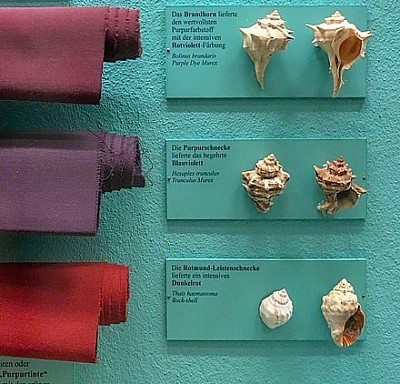Why the Murex Snail Dye wasn't Blue in Ancient Times
Tyrian Purple is a purple dye pigment made from the mucus of several species of Murex snail. In particular the Hexaplex trunculus is the snail being used by Ptil Tekhelet. This group puts forward that this snail's dye was the original blue tekheleth used by Ancient Israelites. However Israeli chemist, Zvi C. Koren, disputes this, in his articles responding to the assertions of Baruch Sterman and Judy Taubes Sterman of the Ptil Tekhelt Foundation group. Professor Zvi C. Koren is the director of the Edelstein Center for the Analysis of Ancient Artifacts at the Shenker College of Engineering and Design in Ramat Gan, Israel.
This picture of the different snails and the dyes they each give came from Wikipedia's article on 'Tyrian Purple', see here.
I have taken excerpts from two of Zvi C.Koren's articles explaining why the dye from these snails could not have produced a blue in ancient times. He still believes that these snails produced the dye used for biblical purposes, but that tekheleth is actually purple, not blue.
It would be helpful to have a brief understanding of the chemistry that Zvi Koren is referring to, so it can understood why he is correct. If you go here, you can quickly see the process and the important elements required to understand what he will be talking about.
These are excerpts from the articles:
'The ANCIENTS—Jewish or non-Jewish—could not, and would not, produce daylight sky-blue from the snail pigments with the methods, materials and tools available to the ANCIENT dyer.'
My published scientific experiments with completely all-natural dyeings with the snail pigments clearly show that air must be prevented from entering the dye bath and thus this solution would have needed to be covered at all times, except for the very brief periods of gentle stirring.
Glass is obviously transparent, but in ancient times the Phoenicians and their contemporaries used CLAY vats (the Romans also used metal pots), which are obviously NON-transparent. Thus, light would not—could not—have entered the solution, especially since the solution needed to be covered as I stated above.
In conclusion, based on my experiments and chemical investigations of the science of this process and of the science associated with the snail pigments, the only possible color of tekhelet-dyed wool is blue-purple, as my analyses have shown that it has violet as well as both blue and red dye components. The shades could of course be referred to as purplish blue or bluish purple, but NOT blue or daylight sky-blue!
"The authors’ (the Stremans) organization uses a method known since the 1930s, which was also used by my late colleague, Prof. Elsner, that transforms much of the red and violet components in the dissolved pigment to the blue indigo dye by exposing the dye solution to sunlight. This method does not produce “pure” indigo, as the authors state; my chemical analyses show that the other components are still present. In addition, this technique is performed by first dissolving the pigment with a strongly reactive synthetic chemical reagent not available in antiquity.
Fourthly, in my experiments with the pigment, the only way in antiquity that the pigment could be dissolved by using only the natural materials available at the time was by the very slow bacterial action under anaerobic conditions, which thus required eliminating as much air (oxygen) as possible from entering the dye solution. In order to accomplish this, it was thus necessary to cover the dyeing vessel without exposing the dye solution to the action of the sun, and thus the original red and violet components in the pigment would be essentially unchanged."
A Few Final Thoughts!
Clear glass was essential to expose this dye to ultraviolet light, to allow the Murex dye to turn blue. Alas, clear glass was not realized until about 100CE. Wikipedia says; 'With the discovery of clear glass (through the introduction of manganese dioxide), by glass blowers in Alexandria circa 100 AD'..., here
The last thought I'd like to leave you with is that if the Murex snail dye did not give a blue in ancient times, then the archeological finds of blue indigo, earlier that 100CE can never be attributed to the Murex indigo dye!


